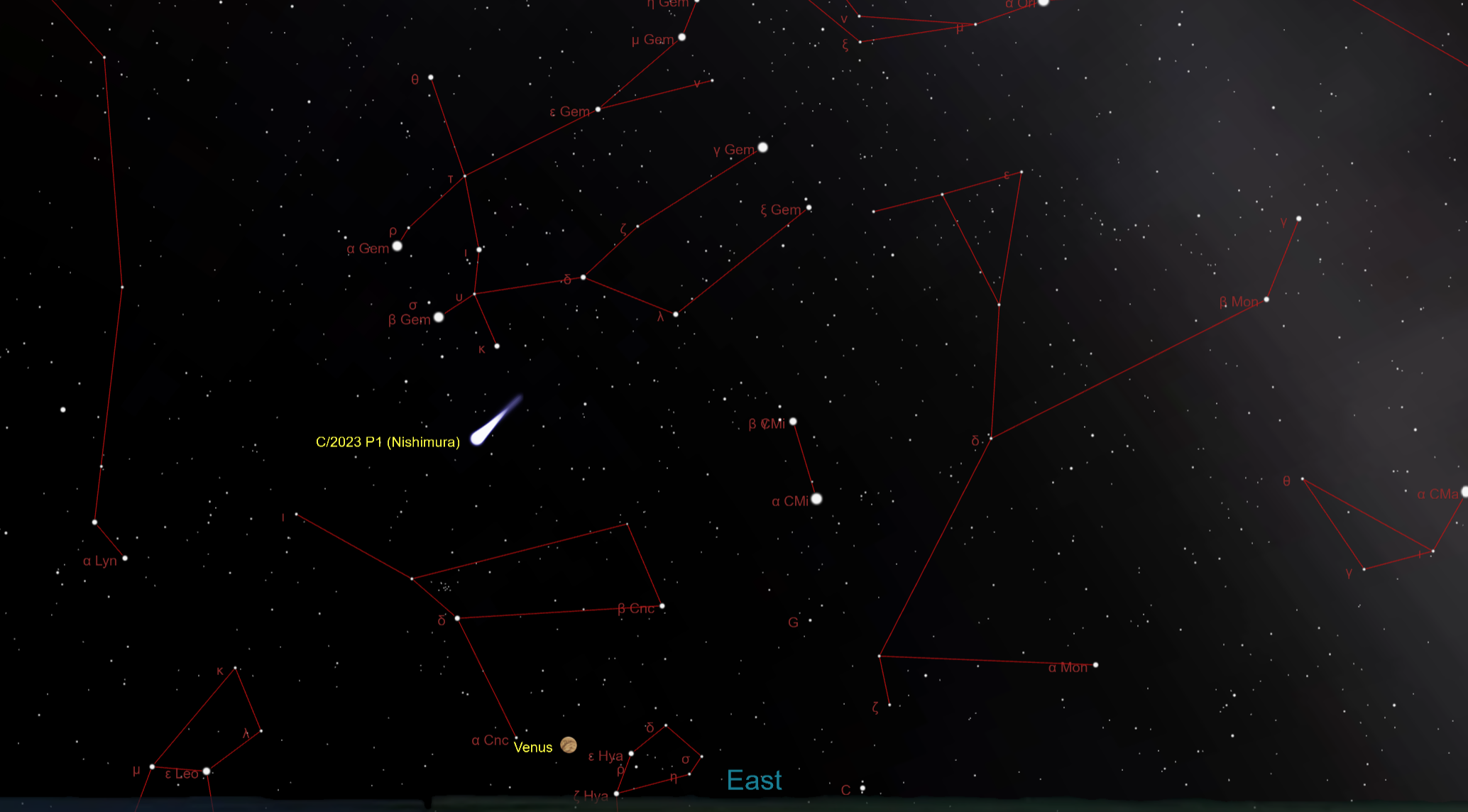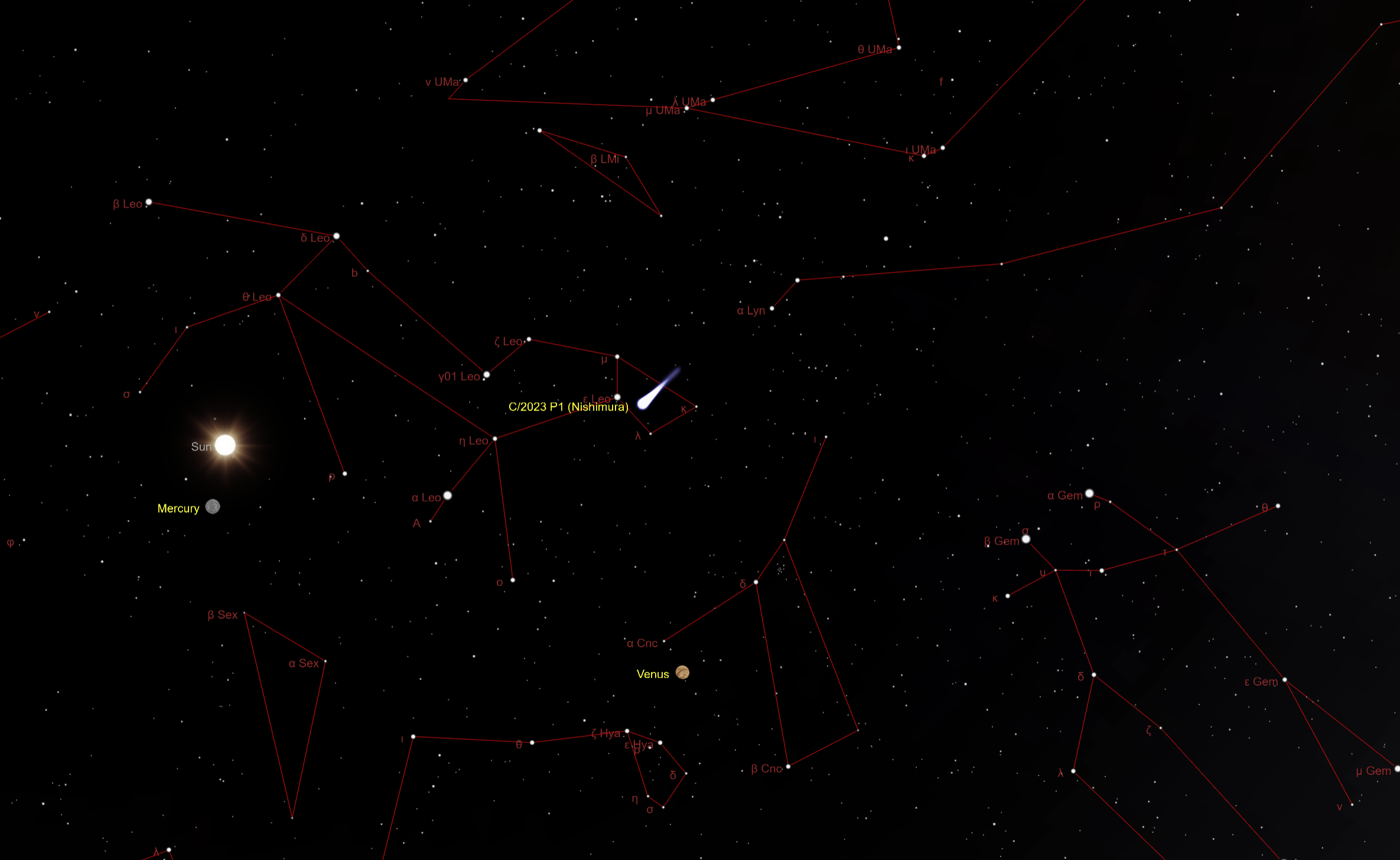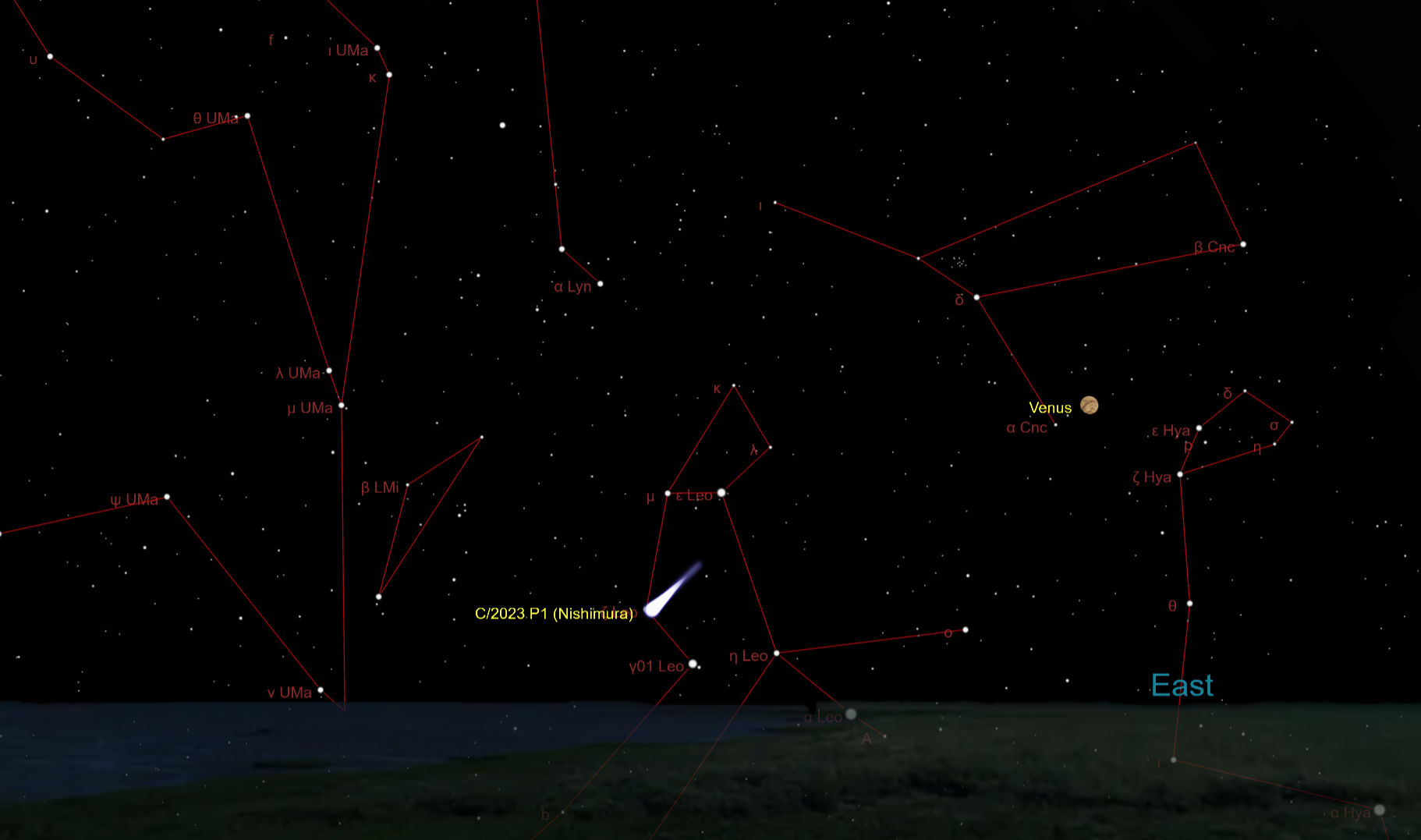Will newfound Comet Nishimura really be visible to the naked eye? Experts aren't so sure

In recent days, the social media pipeline has been promoting the prospects for a bright new comet for September.
The new object was discovered by Japanese amateur astronomer Hideo Nishimura of Kakegawa City, Japan, on Aug. 12th, which is news in itself. These days, the lion's share of new comet discoveries are being made using robotic cameras which are constantly scanning the skies, primarily for asteroids that might make close approaches to Earth.
As a result, we have comets whose monikers represent acronyms such as ATLAS, PanSTARRS and ZTF as opposed to the names of people. These robotic cameras are quite efficient in catching an incoming comet when they are far out in space, well before they become bright enough for human eyes to sight through a telescope.
And actually, Nishimura did not make the initial sighting with his own eyes, but rather, he used a 200-mm f/3 telephoto lens, which was mounted on a 20.2-megapixel full-frame CMOS digital single-lens reflex camera manufactured by Canon. That he was able to discover an approaching new comet when it was already crossing the Earth's orbit before any automated survey saw it is quite an accomplishment. The comet is now officially cataloged as C/2023 P1 (Nishimura). This is Mr. Nishimura's third comet discovery after Comet Nakamura-Nishimura-Machholz (C/1994 N1) and an earlier Comet Nishimura (C/2021 O1).
Related: Watch 1 month in the life of a green comet during its journey past Earth (video)
At the time of its discovery, the comet was in the constellation of Gemini the Twins and shining at magnitude +10.4, or about 40 times fainter than a star on the threshold of naked-eye visibility.
Destined to grow much brighter

Want to see comets in the night sky? We recommend the Celestron Astro Fi 102 as the top pick in our best beginner's telescope guide.
When an orbit for comet Nishimura was computed, however, it showed that the comet was rapidly approaching both the Earth and the sun. The comet will make its closest approach to Earth on Sept. 12 at a distance of 77.9 million miles (125.3 million km), and five days later it will arrive at perihelion — its closest approach to the sun — at a distance of 20.92 million miles (33.66 million km).
Breaking space news, the latest updates on rocket launches, skywatching events and more!
These values initially suggest that comet Nishimura will brighten quickly in the days to come. Indeed, since its discovery it has been doing just that. On Aug. 23, veteran comet observer Carl Hergenrother of Arizona reported the comet's brightness had risen to magnitude +7.9; an increase of 10-fold since its discovery eleven days earlier. According to the reputable comet expert Seiichi Yoshida, comet Nishimura could approach second magnitude in brightness (as bright as Polaris, the North Star) when it is nearest to the sun on Sept. 17.
Hence the reason that many websites are proclaiming that a bright comet will be readily available to be seen in September.
But while it may get bright, actually making a sighting of it will become increasingly problematic after the first week of September.
Bright, but not so easy to see
If you want to see this new comet for yourself, you'll need to rise early in the morning; generally, between one and half to two hours before sunrise. You'll also need good binoculars or a telescope, since it is not yet bright enough to see with your bare eyes alone. It will also help to have access to a dark sky, well away from any bright lights. And you should also have the comet's nightly path through the constellations plotted out so that you'll know exactly where to look.
And most important of all, try to find a site with a clear and unobstructed view of the east-northeast sky. That is where your quarry will be.
Here's where to look
On Saturday morning, Aug. 26, you can use two bright stars to point the way in the direction of comet Nishimura. Look for the two stars that mark the heads of Gemini, Pollux and Castor. If you trace an imaginary line between these stars and then continue downward roughly one and half times the distance between the two, you'll be very close to where the comet will be, about 20 degrees above the horizon. Your clenched fist held at arm's length measures roughly 10 degrees, so the comet will be sitting about "two-fists" up from the horizon.
From Aug. 26 through Sept. 4, the comet will track through the faint stars of Cancer the Crab. Beginning on Sept. 5, the comet will take a path across the top of the well-known asterism known as "The Sickle" — the backward question mark star pattern marking the head and mane of Leo the Lion.
Comet Nishimura will continue to brighten through this time frame, reaching fifth magnitude and possibly becoming bright enough to glimpse with the unaided eye by Sept. 5. Four days later, it may have more than doubled in brightness to fourth magnitude.
Unfortunately, as the comet approaches the sun, it will be dropping lower and lower in the east-northeast sky with each passing morning. By Sept. 9, it will be only about 10 degrees ("one-fist") above the horizon as the twilight sky brightens. And by the morning of Sept. 12, though it might have brightened to third magnitude, it will be sitting just above the horizon and the combination of the twilight, plus any low-altitude haze, will make it very difficult, if not impossible to see. And that will likely be your last opportunity to see it.
I have even seen some websites suggesting to look for the comet on the day that it is passing closest to the sun (Sept. 17), that it will be visible in the evening sky and it will be located almost directly above the sun at sunset. By then the comet may be shining as bright as second magnitude. Unfortunately, it will only be a scant 11 degrees from the sun and almost certainly will be drowned out by the very bright solar glare.
In order to catch sight of an object that close to the sun, it would have to be a good many times brighter ... like Venus or at the very least, Jupiter. And there is also a "chance" according to NASA, that coming so near to the sun, the comet could break up or disintegrate.
Comet expert provides his opinion
Recently, I was a speaker at the annual Stellafane Convention near Springfield, Vermont. Each year about a thousand stargazers gather during a summer weekend to listen to interesting talks during the day, and observe a dark and starry New England sky at night.
It was my good fortune this year to cross paths with Daniel Green of the Central Bureau for Astronomical Telegrams (CBAT); the clearinghouse for announcements of astronomical discoveries. Dan has been tracking and predicting the movement of comets for some four decades at the CBAT and with the discovery of comet Nishimura, I asked him what he thought the chances were for it to develop into an eye-catching object.
"I don't really think the chances are all that good," he said. "Along with the fact that it will be rather low in the early morning sky, and as we move through the early part of September, morning twilight will begin encroaching on its visibility, it appears that what we are dealing with is primarily a comet that is emitting a lot of gas and very little dust."
Better dusty than gassy
Comets can be broken into two categories. The comets that put on an impressive show, with a bright star-like head and bright gossamer tails, are dusty comets. Indeed, dust particles are excellent reflectors of sunlight. In contrast, there are comets which shine by virtue of gasses that glow in much the same way as fluorescent paint shines under ultraviolet or "black" light. Such comets appear much dimmer accompanied by long, faint tails. Such tails appear quite impressive in long-exposure photographs, but are hardly visible to the eye.
"That's why I'm not expecting a lot from Nishimura," Green added.
Indeed, this is a comet that appears to be rich in volatile carbon gas. For experienced amateur astronomers, compared to most other comets, this is an unusually bright and potentially photogenic comet.
But for most looking to see a memorable sight, beware! At best, through good binoculars or a telescope, be prepared to see nothing more than a roundish, wispy blob of bluish-green light and "maybe" a hint of a faint tail.
Finally, comet Nishimura may be new to us, but it's hardly new as a member of the solar system. Its orbit indicates that it takes about 294 years to make one full circuit around the sun and it has probably passed through the inner solar system innumerable times in the past.
And maybe it will put on a better show for us when it returns around the year 2317.
If you are hoping to catch a look at comets in the night sky, our guide to the best binoculars could help you find some nice wide-angle optics for taking in larger areas of the sky. Or, if you want to take a closer look at either one, our guide to the best telescopes can help you find the gear you need.
And if you're looking to take photos of these celestial objects or the night sky in general, check out our guide on how to photograph comets, as well as our best cameras for astrophotography and best lenses for astrophotography.
Joe Rao serves as an instructor and guest lecturer at New York's Hayden Planetarium. He writes about astronomy for Natural History magazine, the Farmers' Almanac and other publications.
Editor's Note: If you snap an image of Comet Nishimura and would like to share it with Space.com's readers, send your photo(s), comments, and your name and location to spacephotos@space.com.

Joe Rao is Space.com's skywatching columnist, as well as a veteran meteorologist and eclipse chaser who also serves as an instructor and guest lecturer at New York's Hayden Planetarium. He writes about astronomy for Natural History magazine, Sky & Telescope and other publications. Joe is an 8-time Emmy-nominated meteorologist who served the Putnam Valley region of New York for over 21 years. You can find him on Twitter and YouTube tracking lunar and solar eclipses, meteor showers and more. To find out Joe's latest project, visit him on Twitter.




